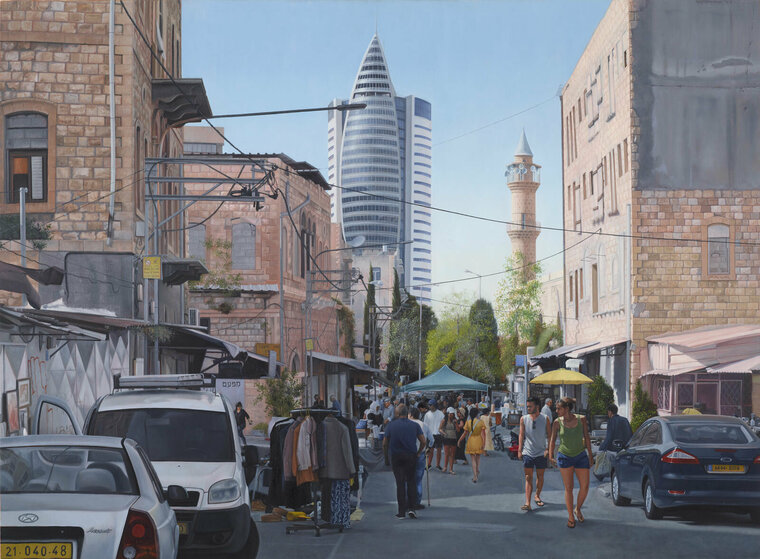Flea Market Haifa, 2019, by Palestinian hyperrealist artist Michael Halak is an oil painting that offers a snapshot of a dynamic street scene in Haifa that is bustling with activity. Haifa is considered unique because it is perceived as a ‘mixed-city’ and a site of Arab-Jewish coexistence. As an urban public space, it is presented as a location where tradition is actively maintained in the process for achieving progress. The scene is grounded by historical stone buildings, their weathered textures and arched windows anchoring the composition in tradition and history. These older structures stand in stark contrast to the sleek, modern skyscraper in the background. On the right, a minaret reaches skyward, adding a layer of cultural and religious significance to the tableau.
Flea Market Haifa highlights the encroachment of modern structures into the architectural fabric of the old souk. In this way, it juxtaposes the old and the new, and in the process provides a snapshot of the potential destruction of history in the quest for modernization. Simultaneously, it shows the coexistence of various architectural styles and, by extension, the cultural and temporal layers they represent. The older buildings and the minaret speak to the city's rich past and Arab population, while the contemporary skyscraper symbolizes an aspirational future. The flea market breathes life into the scene, a microcosm of society where the past is repurposed for the present.
The label ‘flea market’ known as ‘marché au puce’ in French, officially opened in 1885, also connotes an element of the unseemly: one possible explanation for why it was called as such was because fleas were thought to have infested the furniture that was sold there in the late 19th century. Modern flea markets, however, function as a public space where individuals can interact more closely with specific aspects of local culture, such as antiques, second hand objects, food and local cuisine, music, and art.
Halak's work frequently explores the boundary between hyperrealism and conceptualism, exploring the illusion of reality and its multifaceted interpretations. His work conveys a feeling of disruption and disintegration. It depicts impermanence, and entrapment. More specifically it refers to the urbanization of Haifa , once an old historical city, today known as the “Palestinian cultural capital in Israel.” Haifa was an important cosmopolitan center prior to the loss of its majority Palestinian population in 1948. Halak plays with our perception to make us feel what he feels, to experience his reality: a life in transition, in a place that is not really his.
signed M.H.2019 front lower right as car license plate




